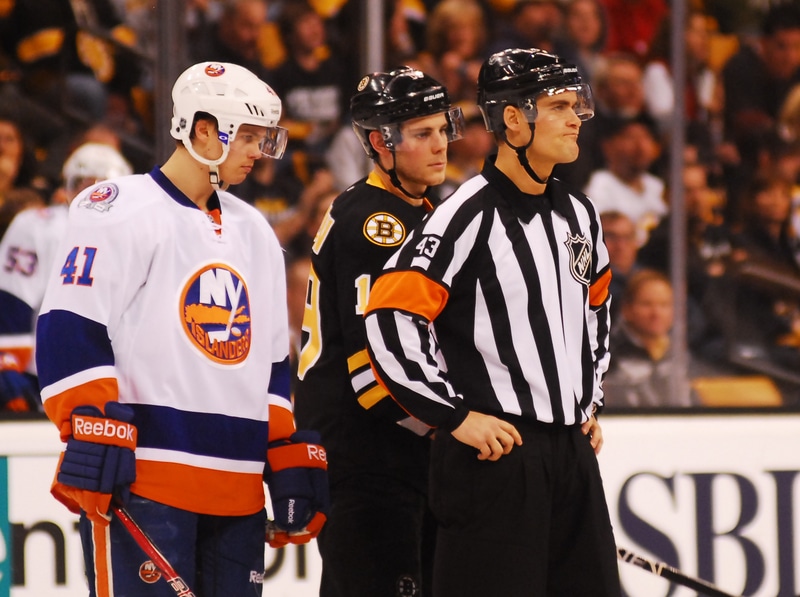Last updated on November 3rd, 2023 at 03:31 pm
A linesman is a type of on-ice official during a hockey game. The primary job of a hockey linesman is to call any infractions of the rules during a game. Some common infractions that the linesman is looking for are offside plays at the blue line or icing the puck.
So, what is the difference between a hockey referee and a linesman? How many linesmen are there in a hockey game? Can a linesman call a penalty or stop play during a game? How much do these officials tend to make during a regular season?
Here is the complete breakdown of what a linesman does during a hockey game.
What is the Difference Between a Hockey Referee and Linesman?
Though hockey referees and linesmen are both on-ice officials during a hockey game, there are a few key differences between them. On-ice officials are those who lace up their skates and are active on the ice to ensure that a fair game is being played. During a hockey game, there are also off-ice officials, such as the goal judge and the official scorer.
The referees are responsible for calling penalties and enforcing all the game rules. Referees are also responsible for dropping the puck at the center ice red line at the start of the game. However, a linesman is only responsible for calling line violations like offside or icing. A linesman will also assist the referees in making the correct call whenever the need arises.
Additionally, the two officials will wear identical uniforms, except that referees will have a red or orange armband to differentiate between the two. The linesmen may also need to break up hockey players in an altercation and conduct ice faceoffs throughout the game.
How Many Linesmen Are There in a Hockey Game?
The number of linesmen in a hockey game varies depending on the ice hockey being played. Both the National Hockey League and NCAA hockey use a four-official system. This system includes two NHL referees and two NHL Linesmen.
A three-official system is used in the AHL and all levels below the AHL (including women’s NCAA ice hockey). There is only one referee in this system, while there are two linesmen.
Most youth and school-level ice hockey use a two-official system. In this system, there are two on-ice officials. Both of these officials work together, taking on the responsibilities of both the referee and the linesman.
Can a Linesman Call a Penalty in Hockey?
While a referee is the only official that can assess penalties for any violation of the rules, a linesman can report any significant penalties they notice. For instance, a linesman might see too many men on the ice. Linesmen are also responsible for calling penalties, such as icing and offsides. After calling these penalties, the linesman will then conduct the faceoff.
Linesmen can also stop the gameplay for other reasons besides their normal line violations. Some examples of these other reasons for stopping the game include objects thrown on the ice surface, unsportsmanlike conduct, and high sticking. High sticking is when one player on the rink carries his stick above his opponent’s shoulder and then uses it to make contact with a player from the opposing team.
Can a Linesman Stop Play?
Though the referees usually make penalty calls, there are also certain cases when a linesman can order a stoppage of play. Hand passes, high sticking, and too many men on the ice are common penalties that linesmen may make outside their normal jurisdiction. Hooking is another great example of these situations.
Besides penalties, a linesman can call for a stoppage of play for situations when items have been thrown onto the ice, either by disgruntled players or overly excited fans.
Conclusion: What Does a Linesman Do in Hockey?
In summary, an NHL linesman is an on-ice official who mainly calls on blue-line violations and icing the puck. In contrast, a referee is responsible for calling all other penalties and enforcing the game’s rules. Four on-ice officials are present during a National Hockey League game: two referees and two linesmen.
While the referee is usually the one calling the penalties, there are some situations when the linesman can call a penalty. Some examples include high sticking, unsportsmanlike behavior, and too many men on the ice.
A linesman is also responsible for stopping the play if someone throws something onto the ice and breaking up any fights that occur on the ice. While the profession of an NHL linesman can make you a fairly decent living, it was not always the case. Luckily the pay scale has settled into one that everyone agreed upon.
Similar Posts:
How Do Line Changes Work in Hockey?
How Long is a Hockey Intermission?
What is a Power Play in Hockey?
What is a Penalty Shot in Hockey?
Greg Kristan, owner of The Stadium Reviews, LLC and TM Blast, LLC, brings his extensive experience visiting over half of the MLB ballparks, along with numerous MLS, NHL, NBA, and NFL venues, to provide in-depth coverage on the bag policy, food options, and parking. He has also been interviewed about his experiences on several sports podcasts.






